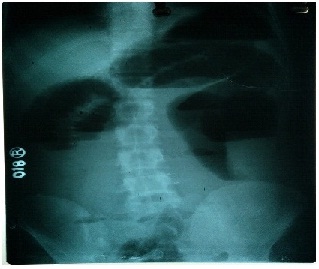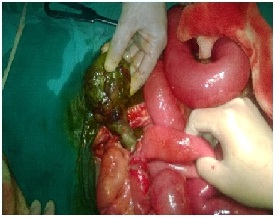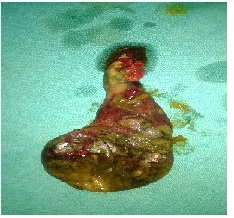Case Report

Gangrenous Meckel’s Diverticulum in an Adult: a Case Report
*Ram Niwas Meena,*Venkat Mukunda ,*Ranjeet Kumar Singh,*Rahul Khanna,
- *Department of General Surgery, Institute of Medical Sciences, Banaras Hindu University, Varanasi – 221005
- Submitted: Tuesday, July 01, 2014
- Accepted: Tuesday, October 21, 2014
- Published: Sunday, November 09, 2014
This is an Open Access article distributed under the terms of
the Creative Commons Attribution License
(http://creativecommons.org/licenses/by/3.0)which permits unrestricted use, distribution, and reproduction in any medium, provided the original work is properly cited
Abstract
Introduction
Meckel’s diverticulum (MD) is the most common congenital abnormality of the gastrointestinal tract, although complications from a Meckel’s diverticulum are rarely seen in the adult population.
Case Report
We are reporting the rare occurrence of a huge gangrenous Meckel’s diverticulum in an adult, which was managed successfully by emergency laparotomy and resection. A 25-year man presented with four days history of pain abdomen, recurrent vomiting, abdomen distention, low grade fever and non-passage of flatus and stool. X ray of abdomen in erect posture show dilated bowel loop. The patient underwent emergency laparotomy. A huge gangrenous Meckel’s diverticulum was found for which resection and anastomosis of the ileum was done.
Conclusion
This case serves to highlight the surgical emergency of Meckel’s diverticulum in an adult.
Key Words
gangrenous meckel’s diverticulum, emergency surgery, acute abdomen.
Introduction
Meckel’s diverticulum (MD) is the most common congenital abnormality of the gastrointestinal tract; it is a true diverticulum that develops from the incomplete obliteration of the omphalomesenteric duct during embryonic development. MD generally remains asymptomatic, and complications are reported in only 2–3% of cases [1]. Complications that arise due to a Meckel’s diverticulum include bleeding, obstruction, inflammation and less commonly, perforation. Although complications from a Meckel’s diverticulum are rarely seen in the adult population, when observed, emergency surgery is often required.
Case Report
A 25 year old man presented in emergency with complaints of pain abdomen from five days distention of abdomen, vomiting, low grade fever, inability to pass flatus and stool from four days. No history of haematemesis, melaena and surgery in past. On examination abdomen was distended with guarding and rebound tenderness. All blood investigation was normal except raised total count 14.2 x10 /μl with 86% neutrophils. Plain x ray of abdominal revealed dilated small bowel loops (Figure 1). Acute intestinal obstruction was diagnosed, and an emergency laparotomy was performed. Intraoperatively, we found that peritoneal cavity was filled with bloody fluid and a black, axially torsed, gangrenous Meckel’s diverticulum, measuring 15 x4 cm was located 60 cm proximal to the ileocaecal region (Figure 2). Resection and anastomosis of the ileum was done under general anaesthesia (Figure 3). Patients receive injectable antibiotic ceftazidime, ofloxacin, ornidazole for six days.

Figure 1: X-ray of abdomen in erect posture showing dilated small bowel loop.

Figure 2: Interaoperative Gangrenous Meckel’s Diverticulum

Figure 3: Resected specimen Gangrenous Meckel’s Diverticulum
Histological findings confirmed the diagnosis of gangrenous Meckel’s diverticulum. The postoperative course was uneventful and the patient was discharged on the seven postoperative days.
Discussion
MD is congenital and occurs in approximately 2% of the general population. In the majority of cases, MD remains asymptomatic. In all age groups, there is only a 4–6% overall lifetime risk of developing complications that require surgery [2 3].
Meckel’s diverticulum occurs on the antimesenteric border of the ileum and in 90 percent of the cases within 90 cm from the ileocecal valve, although there have been reported diverticula up to 180 cm from the ileocaecal valve, in our case it was 60 cm from ileocaecal region.
The size is variable, but diverticulum typically presents as short and wide mouthed (on average it is 2.9 cm long and 1.9 cm wide). In the present case, the diverticulum was much larger in size (15×4 cm), compared to the average proportions [3 4 5 6], which is a rare finding in itself.
Torsion of a MD is a rare complication. The subsequent development of gangrene in a twisted MD is also reported to be extremely rare [4]. Axial torsion of the diverticulum around its base, and consequently gangrene, has been related with attachment of the diverticulum to the umbilicus or to the ileal mesentery. Axial torsion of the diverticulum, around a narrow base can also occur [5]. In our case, axial torsion of the diverticulum occurred around its narrow base, resulting in compromised blood supply and gangrene. No attachment to adjacent anatomic structures was identified.
There are only three previously reported cases of giant gangrenous Meckel’s diverticulum caused by axial torsion [6 7 8]. In two cases, the patients underwent laparotomy, with one patient requiring resection of the involved small bowel with primary anastomosis and one patient underwent laparoscopic resection.
Conclusion
A very rare form of acute abdominal pain caused by a torsed gangrenous MD Delay in the diagnosis of a complicated Meckel’s diverticulum can lead to significant morbidity and mortality so it require a high degree of suspicion, as an accurate preoperative clinical diagnosis is often difficult to make
Authors Contribution
RNM: did the literature search and prepared the draft manuscript
VM: Helped in preparation of draft manuscript
MK: Helped in acquisition of data and analysis
RK: Conceived and designed the study and edited the final version
All authors have read and approved the manuscript
Ethical consideration
Patient consent was obtained for reporting of this case
Conflicts of interest
The authors declare that there are no Conflicts of interest
Funding
None Declared
References
[1].Ludtke FE, Mende V, Kohler H, Lepsien G: Incidence and frequency or complications and management of Meckel’s diverticulum. Surg Gynecol Obstet 1989; 169:537–542.
[Pubmed]
[2].St-Vil D, Brandt ML, Panic S, Bensoussan AL, and Blanchard H: Meckel’s diverticulum in children: a 20-year review. J Pediatr Surg 1991; 26:1289–1292.
[Pubmed]
[3].Cullen JJ, Kelly KA, Moir CR, Hodge DO, Zinsmeister AR, Melton LJ 3rd: Surgical management of Meckel’s diverticulum. An epidemiologic, population-based study. Ann Surg 1994; 220:564–568; discussion 568–569.
[Pubmed]
[4].Limas C, Seretis K, Soultanidis C, Anagnostoulis S: Axial torsion and gangrene of a giant Meckel’s diverticulum. J Gastrointest Liver Dis 2006; 15:67–68[Pubmed]
[5].Malhotra S, Roth DA, Gouge TH et al. Gangrene of Meckel’s diverticulum secondary to axial torsion: a rare complication. Am J Gastroenterol. 1998; 93:1373-1375.[Pubmed]
[6].Limas C, Seretis K, Soultanidis C, Anagnostoulis S, et al. Axial torsion and gangrene of a giant Meckel’s diverticulum. J Gastrointestin Liver Dis 2006; 15:67-68
[Pubmed]
[7].Nunes QM, Hotouras A, Tiwari S, Sheth A. Gangrene due to axial torsion of a Giant Meckel’s Diverticulum containing multiple stones in the lumen:a case report. Cases J 2009; 2:7141[Pubmed]
[8].Ong MW, Tan KK, Sim R: laparoscopic resection of a huge gangrenous meckel’s diverticulum in an adult, Singapur Med J 2013 ;54(4):e83-e84
[Pubmed]

